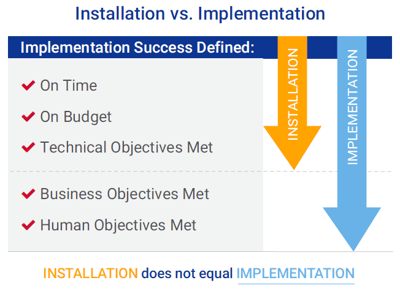Hint: it may not be when you think!
What is the end goal for your strategic initiatives? While it may seem like an obvious question, you’d be surprised at the number of organizations that get it wrong. Whether it is new technology, Agile, continuous improvement such as Lean/Six Sigma, restructuring or a business/clinical transformation, most organizations focus on getting to go-live. Shortly after that date, the project team is dismantled, and the initiative is checked off as complete and probably “successful.” 
But if you look around the organization, what has actually changed? Sure, there has been a lot of activity and maybe some results. This is what Don Harrison, the developer of the AIM Change Management Methodology, calls successful Installation. What these organizations don’t understand is that getting to go-live is not the finish line. The truth of the matter is there is no change without sustained behavior change, and that does not happen at go-live.
Why Do Organizations Stop at Installation?
Many organizations are, in fact, very good at installing all kinds of changes. There are several very powerful motivators usually working to sustain an “Installation Mentality:”
- Budget Constraints – Budgets are often developed based on the estimated resources to get to go-live, rather than on getting to sustained adoption, and thus value realization for a change.
- Resource Scarcity – Every organization has too many projects all chasing the same, limited resources. To “spread the wealth,” there is enormous pressure to prematurely reassign resources from one project to another quickly.
- Installation is Easy to Quantify – It’s easy to measure if a project is on time, on budget and to scope. It is much more difficult to measure outcomes in terms of behavior change.
- Sponsors are Rewarded for Getting Things Done – Project Teams and leaders are typically rewarded when lots of things “get done.” A list of quickly completed projects can make a manager appear very accomplished!
Installation is Critical. But it is Not Enough!
Getting to Installation of a project is, of course, important, but if you measure success by Installation you are not getting to behavior change and therefore, true Return on Investment. So, instead of considering go-live as the strategic end goal, organizations need to reframe their definition of success to include all 5 of these critical success measures: 
- It’s delivered on time
- It’s delivered on budget
- The technical objectives are achieved
- The business objectives are achieved
- AND it meets the human objectives that have been established for the change
When the project is delivered on time, on budget and the technical objectives are met, that’s successful Installation. To reach successful Implementation, the business and human objectives must also be met. These human objectives are the behaviors you seek to see in the future. In other words, what will people be doing differently in the future? Not just the people at the front lines of the change, but also leaders, managers and supervisors.
Building an Implementation Mentality
An “Implementation Mindset” is built when there is sufficient rigor and discipline on the human side of organizational changes. To increase that likelihood:
- Have a common Change Management Framework (AIM) and vocabulary that are universally shared across the organization.
- Blend a structured Implementation Plan into the Technical (aka Project) Plan. At a minimum, the plan must include:
- A Complete Change Definition
- A Sponsorship Strategy
- A Readiness Strategy
- A Communication Plan
-A Reinforcement Strategy
- Ensure Sponsors and Agents have clear expectations for their respective roles, and then hold them accountable for Implementation Success. Provide them with the necessary skill development for maximum effectiveness.
- Resource Projects with the right people at the right time. Technical SME’s and Change Agents both with strong relationships with project Sponsors, and with Implementation experience, need to be involved sooner rather than later; ideally during the initial planning stage of a project.
Organizations that focus on true Implementation rather than being content with Installation will greatly enhance the likelihood of achieving project ROI. By following a structured, comprehensive process such as IMA’s proprietary AIM Change Management Methodology, organizations will not only achieve the business, technical and human objectives set out for an initiative; they will get to successful Implementation at speed.


